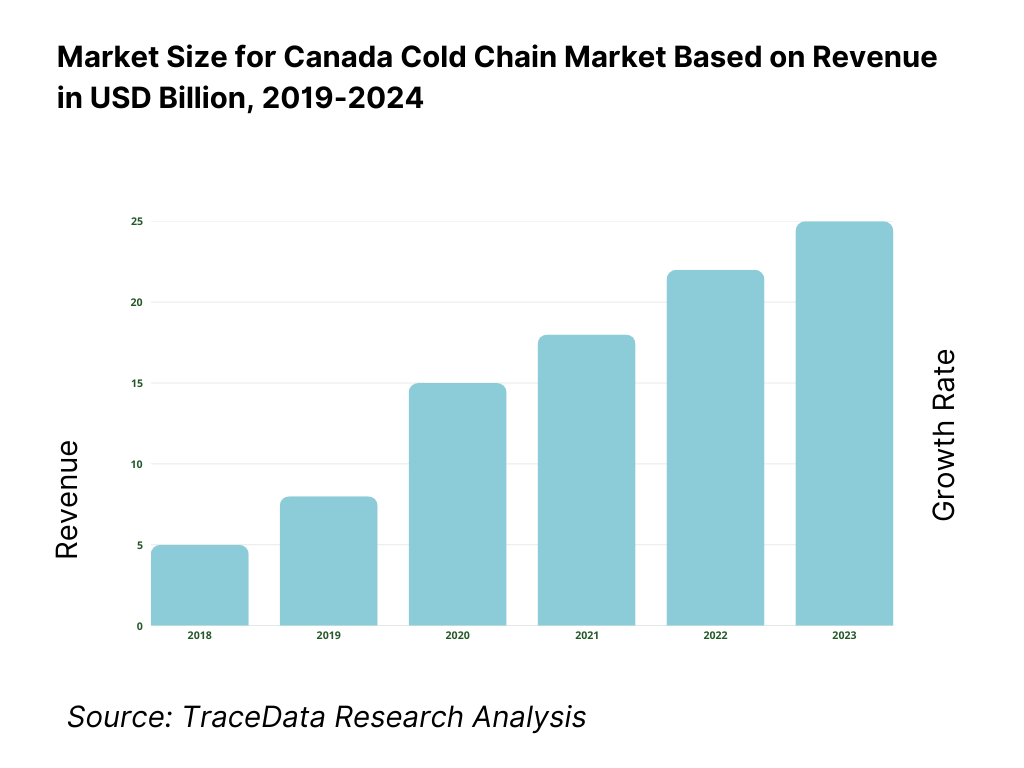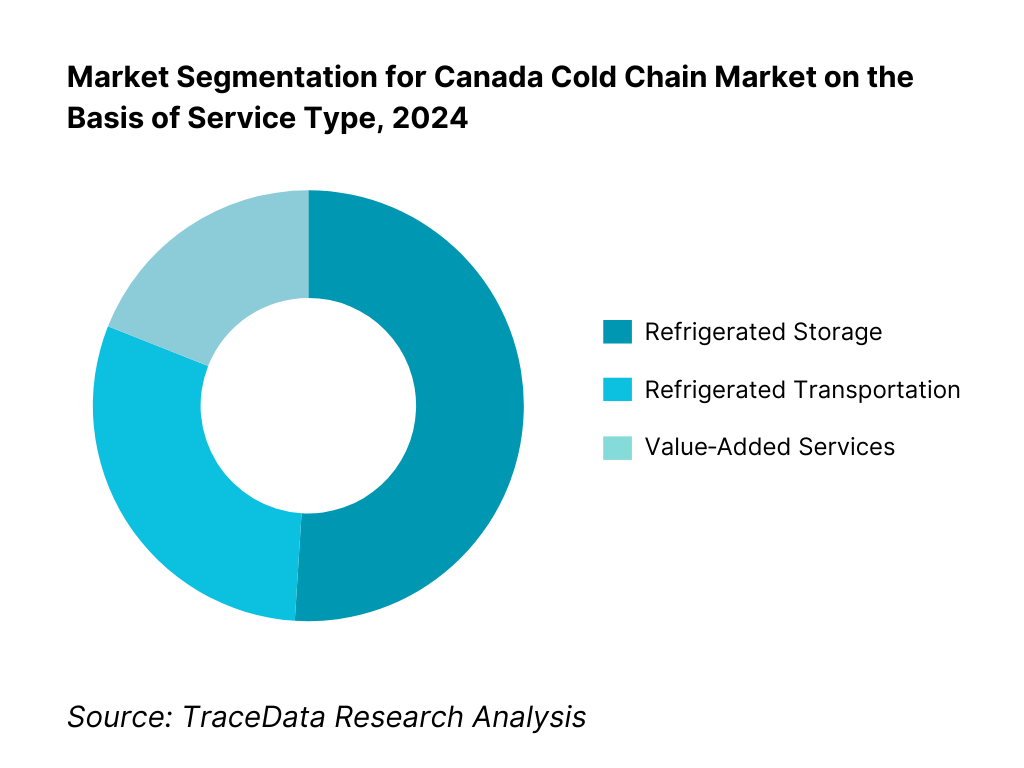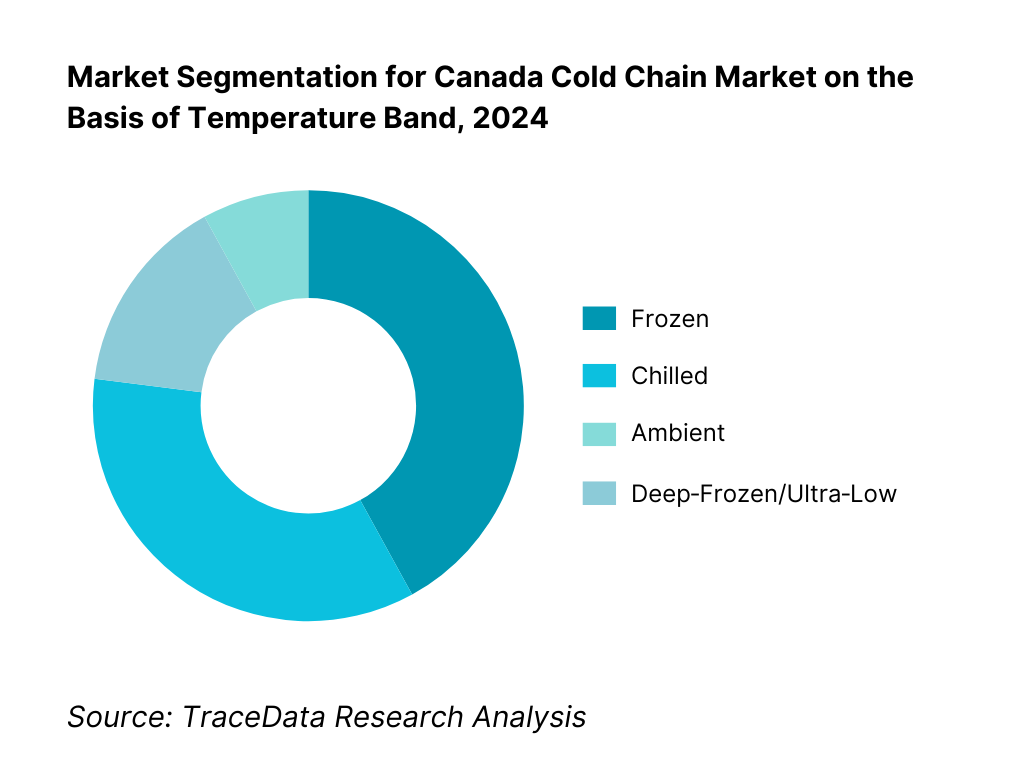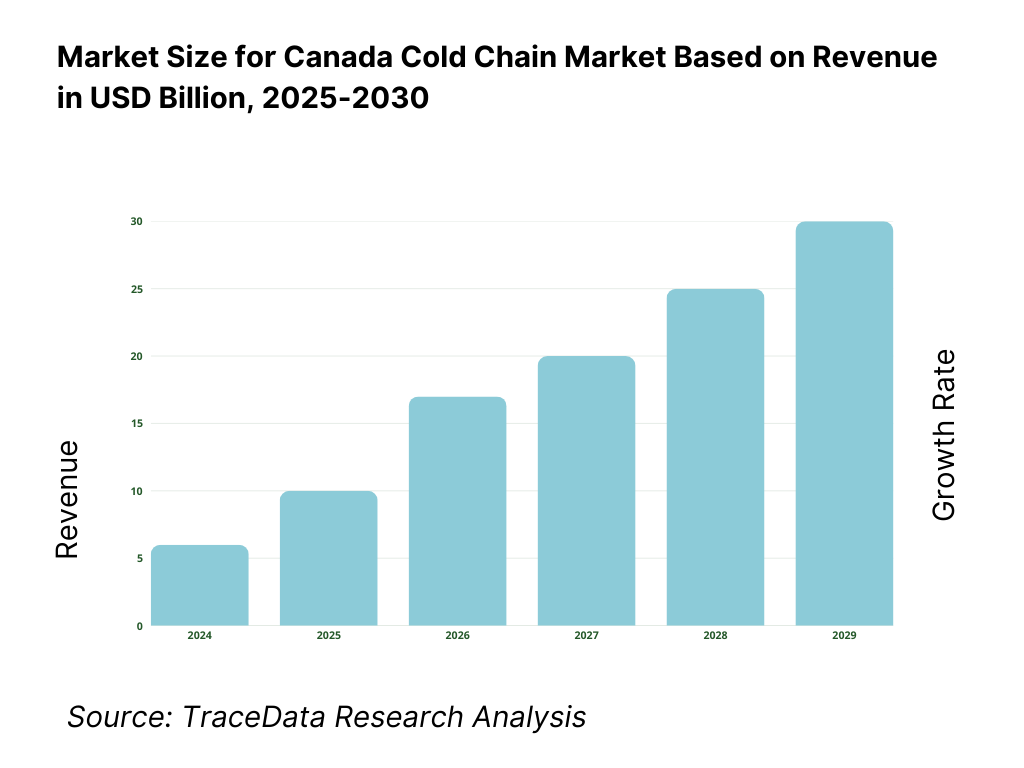Canada Cold Chain Market Outlook to 2030
By Market Structure, By Service Type, By Temperature Range, By End-User Industry, By Mode of Transportation, and By Region
- Product Code: TDR0248
- Region: North America
- Published on: August 2025
- Total Pages: 110
Introducing the World's FirstPay-Per-Section Market Reports
Why pay for the full report when you need just a part?
Start Building Your Report
Scroll down to see available sections
Report Summary
The report titled “Canada Cold Chain Market Outlook to 2030 – By Market Structure, By Service Type, By Temperature Range, By End-User Industry, By Mode of Transportation, and By Region” provides a comprehensive analysis of Canada’s temperature-controlled logistics ecosystem. The study covers the overview and genesis of the industry; overall market size in terms of revenue; and detailed segmentation across refrigerated storage, refrigerated road (TL/LTL), rail intermodal, air & ocean cold chain, and value-added services; chilled, frozen, deep-frozen/ultra-low, and controlled room temperature bands; meat & seafood, dairy & bakery, produce, retail & e-grocery, pharmaceuticals & biologics verticals; road, rail, air, ocean, and multimodal flows; and Western, Central, Atlantic, Northern, and cross-border regions. It further examines trends and developments, the regulatory landscape, customer-level profiling, issues and challenges, and a competitive landscape including competition scenario, cross-comparison, and company profiling of 15 major players. The report concludes with future market projections disaggregated by service lines, temperature bands, end-user industries, transportation modes, and regions; incorporates cause-and-effect relationships linking macro trade flows, infrastructure additions, technology adoption, and regulatory shifts to capacity utilization and throughput; and includes success case studies that highlight the major opportunities and cautions for investors, operators, and shippers.
Canada Cold Chain Market Overview and Size
The Canada cold chain logistics market is valued at approximately USD 6.09 billion as of 2025. This figure reflects a five‑year historical analysis. Market growth is driven by substantial infrastructure investments—such as digital visibility initiatives by Transport Canada and low‑GWP refrigerant upgrades—along with ramping demand for biomanufacturing and perishable food exports.
Central Canada, particularly Ontario and Quebec, dominate due to highly developed agri‑food processing clusters, port and rail‑linked export gateways, and dense population centers requiring refrigerated distribution. Western Canada also plays a strong role, benefitting from deep‑sea ports on the West Coast that serve growing exports of seafood, produce, and perishables to Asia.

What Factors are Leading to the Growth of the Canada Cold Chain Market:
Booming Agricultural Exports Fuel Cold Chain Demand: Canada exported approximately USD 100.3 billion in agriculture and food products in around 2024, making it the world’s ninth-largest exporter in this sector. This volume underscores a substantial demand for reliable cold chain infrastructure to move raw, processed, and perishable goods securely across global markets. The system must support exporting enterprises, of which there were 48,718 active exporters in 2023, the highest since 2005—testament to expanding exporter participation. These figures, reflecting growing export scale and participation, drive demand for cold storage and refrigerated transport to maintain product integrity across long-distance, multi-modal logistics.
Stable Economic Environment Enables Infrastructure Investment: Canada’s GDP in nominal terms reached around USD 2.35 trillion in 2023 and is estimated at USD 2.44 trillion in 2024, reflecting robust economic scale, while real growth rates hovered around 1.5 % annually. This large economic base and consistent growth provide both the fiscal capacity and return expectation needed for long-term investments in cold chain infrastructure. Stable macroeconomic footing supports lenders and operators in committing capital toward warehouse automation, fleet modernization, and sustainability retrofits—essential for a cold chain that upholds quality over increasingly complex supply routes.
Labor Market Availability Sustains Operational Capacity: In early 2025, Canada’s national unemployment rate stood at 6.9 %, with Ontario—key cold chain hub—recording 7.8 % unemployment and Quebec at 6.0 %. These figures indicate availability of labor, which is critical for staffing temperature-controlled warehousing, transportation, and logistics operations. A stable labor supply ensures that cold chain facilities can maintain staffing for operations such as loading, temperature monitoring, and warehousing—activities essential for upholding perishable goods quality. Moreover, participation rates exceeding 65 % underscore workforce engagement that cold chain operators can tap into regionally.
Which Industry Challenges Have Impacted the Growth of the Canada Cold Chain Market:
Declining Productivity Stifles Efficiency Expansion: Canada experienced a productivity decline of 1.8 % in 2023, resulting in GDP per capita falling back to 2017 levels—a drag on competitiveness. For cold chain operators, this implies rising per-unit cost pressure, as labor output diminishes. It restricts ability to upgrade facilities, adopt automation, or integrate advanced telematics—all critical for precision in temperature control and reducing spoilage. Lower productivity diminishes operational margins, limiting investment capacity in cold chain enhancements.
Export Price Deflation Undermines Revenue Potential: In 2023, Canadian merchandise export prices dropped by 6.9 % year-over-year, although volumes grew by 5.7 %, indicating that the earning potential for exporters per unit shipped declined. Cold chain providers, reliant on transport/storage fees, are pressured to reduce prices or bear elevated cost burdens without corresponding rate increases, due to lower export unit revenue. This compresses profitability in refrigerated transport and warehousing segments essential to preserve exported goods.
Rising Energy Costs Strain Cold Chain Operations: Though exact figures for energy are not provided here, Canada’s reliance on energy-intensive refrigeration systems is clear. Coupled with inflationary pressures—consumer inflation having peaked around 8.1 % mid-2022 before moderating—which impacts energy and labor costs, cold chain operators face significantly increased operating expenses. Elevated utility and wage costs heat the operating model, challenging margins in an industry already capital and energy intensive.
What are the Regulations and Initiatives which have Governed the Market:
Guidelines for Environmental Control of Drug Products (GUI-0069): Health Canada’s GUI-0069 sets mandatory environmental standards for storage and transportation of pharmaceutical products, including temperature, monitoring, and documentation requirements. All entities handling drugs must comply with Food and Drug Regulations (C.02.015), and contract storage or transport firms must ensure their systems adhere to GMP-level controls. This regulation governs operations significantly in cold chain logistics servicing health sector clients.
Canadian Environmental Protection Act (CEPA) Refrigerant Standards: The Canadian Environmental Protection Act mandates the phase-down of ozone-depleting and high-GWP refrigerants used in cold storage facilities. Cold chain operators must comply with standards and restrictions, necessitating upgrades to low-GWP options like CO₂ or ammonia systems. This regulatory pressure ensures environmental alignment but requires capital investment in refrigeration equipment and compliance tracking systems.
Food Safety & Inspection—Safe Food for Canadians Regulations: Under the Safe Food for Canadians Regulations enforced by the Canadian Food Inspection Agency (CFIA), cold chain providers must meet strict temperature and hygiene standards for any food sold in Canada. CFIA conducts inspections and enforces compliance, requiring robust monitoring, record-keeping, and cold chain traceability. Storage and transport operators face licensing checkpoints and audit obligations based on these food safety regulations.
Canada Cold Chain Market Segmentation
By Service Type: Canada’s cold chain market is segmented into Refrigerated Storage, Refrigerated Transportation, and Value‑Added Services. In 2024, Refrigerated Storage led the market share. This dominance stems from the capital‑intensive nature of warehousing and the pivotal role of multi‑temperature facilities to serve diverse verticals, ranging from food processors to pharma companies, necessitating large-scale cold storage infrastructure.

By Temperature Band: Segments by temperature include Chilled, Frozen, Ambient, and Deep‑Frozen/Ultra‑Low. Frozen applications led the market in 2024. The dominance of frozen logistics is due to high export volumes of meats, seafood, and long shelf‑life perishables, plus growing biologics requiring stable frozen environments, driving demand for robust frozen capacity.

Competitive Landscape in Canada Cold Chain Market
The Canada cold chain market features a handful of major players, including VersaCold, Congebec Logistics, Americold, Lineage Logistics, and others, demonstrating a consolidated landscape. For instance, VersaCold operates Canada’s largest temperature‑sensitive logistics network, with 27 warehouses and a national transport fleet, following its acquisition by Lineage. Congebec holds substantial multi‑temperature warehousing across provinces and ranks among North America’s largest refrigerated providers
Name | Founding Year | Original Headquarters |
VersaCold Logistics Services | 1946 | Vancouver, British Columbia, Canada |
Congebec Logistics | 1974 | Quebec City, Quebec, Canada |
Conestoga Cold Storage | 1974 | Kitchener, Ontario, Canada |
Trenton Cold Storage | 1902 | Trenton, Ontario, Canada |
Confederation Freezers | 1974 | Brampton, Ontario, Canada |
Lineage Logistics | 2012 | Novi, Michigan, USA |
Americold | 1903 | Atlanta, Georgia, USA |
The Erb Group | 1959 | New Hamburg, Ontario, Canada |
Groupe Robert (Cold Chain) | 1946 | Boucherville, Quebec, Canada |
Day & Ross | 1950 | Hartland, New Brunswick, Canada |
Midland Transport | 1970 | Dieppe, New Brunswick, Canada |
Andlauer Healthcare Group | 1991 | Vaughan, Ontario, Canada |
McKesson (Canada operations) | 1833 | New York City, New York, USA |
Canadian National Railway – Temperature-Controlled Cargo | 1919 | Montreal, Quebec, Canada |
Canadian Pacific Railway | 1881 | Montreal, Quebec, Canada |
Some of the Recent Competitor Trends and Key Information About Competitors Include:
VersaCold Logistics Services: As one of the largest temperature-controlled logistics providers in Canada, VersaCold has expanded its national footprint through automation upgrades in its warehouses. In 2024, the company invested in IoT-enabled monitoring systems to enhance end-to-end visibility for food and pharmaceutical clients.
Congebec Logistics: Known for its strong base in Quebec and Ontario, Congebec announced capacity expansions in frozen storage facilities in 2024, targeting the rising demand for meat, seafood, and ready-to-eat frozen foods. The company also strengthened sustainability initiatives by transitioning to low-GWP refrigerants across several sites.
Conestoga Cold Storage: Specializing in frozen food distribution, Conestoga has added new pallet positions in its Kitchener and Guelph facilities in 2024. The company is also piloting energy-efficient high-bay storage systems, aiming to reduce operational costs while maintaining product quality.
Lineage Logistics: A global leader that entered Canada through acquisitions, Lineage Logistics integrated VersaCold’s network in 2024 to consolidate its presence nationwide. The firm has introduced AI-driven demand forecasting tools in Canadian operations, improving inventory management for perishable and pharmaceutical supply chains.
Americold (Canada Operations): In 2024, Americold expanded its presence in Ontario by upgrading facilities with multi-temperature storage solutions. The company has also partnered with Canadian retailers to provide integrated cold chain transport and warehousing solutions, ensuring resilience in cross-border logistics with the U.S.

What Lies Ahead for Canada Cold Chain Market?
The Canada cold chain market is expected to expand steadily over the medium term, supported by sustained agri-food exports, rising e-grocery penetration, biologics and vaccine logistics, and continued investments around port, rail, and airport gateways. Operators will prioritize asset productivity, network resilience, and regulatory compliance (CFIA, Health Canada GUI-0069), while converting legacy plants to low-GWP refrigerants and higher-efficiency systems. Consolidation and infrastructure-led growth should keep shifting share toward scaled 3PLs with multi-province footprints, intermodal connectivity, and digitally orchestrated quality systems.
Shift to Gateway-Centric, Multimodal Networks: Expect deeper integration with West Coast and St. Lawrence ports, plus CN/CPKC temperature-controlled rail products, to de-risk long-haul trucking constraints and curb dwell/surge costs. Port-adjacent hubs with on-dock plugs and cross-dock capacity, along with inland rail-linked DCs, will anchor end-to-end lanes for seafood, meat, produce, and frozen categories. Cross-border flows with the U.S. and single-line Mexico–Canada services will matter more for fresh and frozen throughput reliability.
Outcome-Based SLAs & Quality KPIs: Shippers will push for measurable outcomes—temperature-hold variance, excursion PPM, on-time delivery windows, and mock-recall TAT—hard-wired into contracts. Cold-chain providers will differentiate via validated packaging, route qualification, real-time traceability, and CAPA discipline aligned to GDP and SFCR requirements. Expect wider deployment of product-level data loggers, continuous monitoring, and digital certificates of compliance embedded in shipper ERPs.
Decarbonization & Refrigerant Transition: Operators will accelerate the shift from high-GWP refrigerants to CO₂/NH₃/HFO systems, add heat recovery, doors/air-management retrofits, variable-speed drives, and on-site renewables where feasible. Energy-intensity KPIs (kWh per pallet-week/m³) and emissions per pallet-km will become procurement criteria, influencing network design and vendor selection. Sustainability-linked financing and utility incentives will further nudge retrofit timelines and technology choices.
Automation, High-Bay AS/RS & Labour Productivity: Labour availability and safety will push adoption of high-bay AS/RS, shuttles, mobile racking, and goods-to-person picking, coupled with vision and voice systems tuned for sub-zero environments. Facilities will target higher pallets/m² and pallets/hour throughput while safeguarding cold-chain integrity. Expect predictive maintenance on compressors/evaps and robotic pallet handling in deep-frozen zones to cut downtime and shrink.
Sector-Specific Solutions (Protein, Produce, Pharma): Meat/seafood lanes will emphasize blast-freeze, export compliance, and port-rail orchestration; produce will center on humidity/ethylene controls and rapid cross-docks; pharma/biologics will expand CRT 15–25 °C, 2–8 °C and -20/-70 °C capacity with validated packaging and lane qualification. Healthcare quality systems (mapping, calibration, deviation investigations) will continue to raise the bar for documentation and temperature assurance.
Digitally Orchestrated, Predictive Operations: End-to-end visibility—reefer telematics, lane-level ETA prediction, and exception automation—will become standard. Operators will fuse WMS/TMS data with IoT sensors to anticipate excursions, optimize slotting for SKU velocity and temperature zones, and dynamically route around weather/port disruptions. Data-sharing with shippers and carriers will underpin collaborative planning and continuous improvement cycles.

Canada Cold Chain Market Segmentation
By Service Type
Refrigerated Storage
Refrigerated Transportation (Road TL/LTL)
Intermodal Rail Cold Transport
Air & Ocean Cold Chain Services
Value-Added Services (Cross-docking, Blast-freezing, Packaging)
By Temperature Range
Chilled (0 °C to +4 °C)
Frozen (around –18 °C)
Deep-Frozen / Ultra-Low (< –30 °C)
Controlled Room Temperature (CRT; 15–25 °C)
Multi-Temperature Facilities
By End-User Industry
Meat & Seafood
Dairy & Bakery
Fruits & Vegetables
Retail & E-grocery
Pharmaceuticals & Biologics
By Mode of Transportation
Road (Reefer TL / LTL)
Rail (Temperature-Controlled Intermodal Units)
Air Cargo Cold Chain
Ocean Reefer Containers
Multimodal Solutions
By Region
Western Canada (BC, AB, SK, MB)
Central Canada (ON, QC)
Atlantic Canada (NB, NS, PE, NL)
Northern Territories (YT, NT, NU)
Cross-Border Corridors (US–Canada, Mexico–Canada via CPKC)
Players Mentioned in the Report:
VersaCold
Congebec Logistics
Americold
Lineage Logistics
Trenton Cold Storage
Confederation Freezers
Groupe Robert (Temp‑Controlled)
Erb Group
Day & Ross (Temperature‑Controlled)
Canada Cartage (Specialized/Temp‑Sensitive)
Midland Transport (Refrigerated)
Andlauer Healthcare Group (Healthcare Cold Chain)
McKesson Canada (Pharma Cold Chain)
CPKC – TempPro Intermodal
Canadian National (CN) – Temperature‑Controlled Cargo
Key Target Audience
Supply chain and logistics heads at retail chains (grocery, pharma)
Cold storage facility developers and REITs
Investments and venture capitalist firms evaluating infrastructure and cold‑tech opportunities
Large food processors and exporters (meat, seafood, dairy)
Biopharma distributors and manufacturers
Transport and intermodal service providers (rail, port operators)
Government and regulatory bodies (e.g., Transport Canada, CFIA)
Energy and sustainability officers at major cold‑chain operators
Time Period:
Historical Period: 2019-2024
Base Year: 2025
- Forecast Period: 2025-2030
Report Coverage
Choose individual sections to purchase. Mix and match as you like.
- -
- -
- $100
4.1. Delivery Model Analysis for Cold Chain [Dedicated vs Shared Warehousing, Reefer TL vs LTL, Intermodal, Air & Ocean]-Margins, Preferences, Strengths & Weaknesses
4.2. Revenue Streams for Canada Cold Chain Market [storage, cross-docking, handling fees, reefer transport, pharma packaging, value-added services]
4.3. Business Model Canvas for Canada Cold Chain Market [key partners, activities, value propositions, customer segments, cost & revenue structure]
$2505.1. 3PL vs Captive Cold Chain Operations [grocery retailers vs logistics providers]
5.2. Investment Model in Canada Cold Chain Market [infrastructure funds, REITs, private equity, government funding]
5.3. Comparative Analysis of Network Expansion by Private vs Public Sector [ports, airports, cold hubs]
5.4. Cold Chain Budget Allocation by Company Size [large retailers, SMEs, pharma distributors]
$150- $100
- $200
8.1. Revenues (Historic)
8.2. Year-on-Year Growth
$3009.1. By Market Structure [in-house vs outsourced cold chain]
9.2. By Temperature Range [chilled, frozen, deep frozen, CRT, multi-temp]
9.3. By Industry Verticals [meat & seafood, dairy & produce, retail & e-grocery, pharmaceuticals & biologics, foodservice]
9.3.1. By Meat & Poultry Cold Chain [chill-to-ship cycle, blast-freeze capacity]
9.3.2. By Seafood & Aquaculture Cold Chain [export hubs, port connectivity]
9.3.3. By Dairy & Produce Cold Chain [humidity controls, ethylene management]
9.3.4. By Pharma & Biologics Cold Chain [2-8°C,-20°C,-70°C, CRT compliance]
9.4. By Company Size [large grocery retailers, regional distributors, SMEs]
9.5. By Transport Mode [road TL/LTL, intermodal rail, air cargo, ocean reefer]
9.6. By Service Offering [storage, cross-dock, value-added handling, packaging]
9.7. By Region [Western Canada, Central, Atlantic, Northern Territories]
$40010.1. Corporate Client Landscape and Cohort Analysis [retail, pharma, food processors]
10.2. Cold Chain Needs and Decision-Making Process [service contracts, lane validation]
10.3. Service Effectiveness and ROI Analysis [shrink reduction, energy optimization, SLA compliance]
10.4. Gap Analysis Framework [capacity, regional imbalances, technology adoption]
$50011.1. Trends and Developments in Canada Cold Chain Market [IoT reefer tracking, multi-temp trailers, CO‚‚/NH‚ƒ systems]
11.2. Growth Drivers [e-grocery boom, protein exports, biologics pipeline, port trade]
11.3. SWOT Analysis for Canada Cold Chain Market
11.4. Issues and Challenges [labour shortages, high energy intensity, refrigerant transition, regulatory compliance costs]
11.5. Government Regulations for Canada Cold Chain Market [CFIA, Safe Food for Canadians Act, GUI-0069 pharma guidelines, CSA refrigeration codes]
$20012.1. Market Size and Future Potential for Digital Cold Chain Platforms
12.2. Business Models and Revenue Streams
12.3. Delivery Models and Type of Solutions Offered [WMS, IoT, telematics, AI demand forecasting]
12.4. Cross-Comparison of Leading Digital Cold Chain Platforms [company overview, funding, revenues, number of shippers, pricing, technology stack]
$500- $250
- $150
15.1. Market Share of Key Players [storage capacity, reefer fleet, revenue]
15.2. Benchmark of Key Competitors [company overview, USP, business model, provinces covered, pallet positions, refrigerant system, technology used, major clients, strategic tie-ups, pricing models, ESG disclosures]
15.3. Operating Model Analysis Framework [hub-and-spoke vs decentralized networks]
15.4. Gartner Magic Quadrant [leaders, visionaries, challengers, niche players in Canadian cold chain]
15.5. Bowmans Strategic Clock for Competitive Advantage [price vs differentiation in logistics]
$75016.1. Revenues (Projections)
$30017.1. By Market Structure [in-house vs outsourced cold chain]
17.2. By Temperature Range [chilled, frozen, deep frozen, CRT, multi-temp]
17.3. By Industry Verticals [meat, dairy, pharma, retail, foodservice]
17.3.1. By Meat & Poultry Cold Chain (Future)
17.3.2. By Seafood & Aquaculture Cold Chain (Future)
17.3.3. By Dairy & Produce Cold Chain (Future)
17.3.4. By Pharma & Biologics Cold Chain (Future)
17.4. By Company Size [large vs medium vs SME distributors]
17.5. By Transport Mode [road, rail, air, ocean reefer]
17.6. By Service Offering [storage, cross-dock, value-add, packaging]
17.7. By Region [Western, Central, Atlantic, Northern]
$400- $250
- $250
Research Methodology
Step 1: Ecosystem Creation
We begin by mapping the Canada Cold Chain Market ecosystem, identifying all demand-side and supply-side entities. On the demand side, this includes exporters of meat, seafood, dairy, produce, and pharmaceuticals, along with domestic retailers, e-commerce grocery platforms, and healthcare distributors. On the supply side, we assess 3PL/4PL providers, cold storage operators, reefer transport fleets, rail intermodal players (CN, CPKC), airport and seaport authorities, packaging suppliers, and refrigerant/energy solution providers. From this mapping, we shortlist 5–6 leading operators such as VersaCold, Congebec Logistics, Lineage Logistics, Americold, and Andlauer Healthcare, based on their financials, footprint, and customer base. Ecosystem data is sourced through government trade statistics, CFIA and Health Canada regulatory listings, and industry reports to collate industry-level insights.
Step 2: Desk Research
Next, we conduct exhaustive desk research using secondary and proprietary databases to capture industry-level insights. We aggregate data on:
National cold storage capacity (measured in ft³ and pallet positions)
Transport fleet size (reefer trucks, rail TempPro units, refrigerated containers)
Trade volumes of perishable exports (e.g., seafood, meat, dairy, pharma)
Regulatory environment (SFCR, GUI-0069, CEPA refrigerant mandates)
Investment trends in automation, digital monitoring, and energy efficiency
Additionally, company-level data is analyzed through annual reports, press releases, financial statements, and facility announcements. This ensures a baseline understanding of revenue streams, client industries, geographic reach, and operational practices of major cold chain players.
Step 3: Primary Research
We then initiate in-depth interviews with senior executives and operational managers from cold storage companies, logistics providers, and major shippers. These interviews serve multiple purposes. Validate market hypotheses around growth drivers (e-grocery, pharma, protein exports). Authenticate quantitative data, such as capacity utilization, throughput volumes, and lane coverage. Extract operational and financial insights, such as pricing structures, SLAs, compliance costs, and technology adoption. A bottom-to-top approach is applied to estimate revenue contribution per operator, which is then aggregated to derive overall market revenues. As part of validation, disguised interviews may be conducted under the guise of potential clients, enabling cross-checking of operational and financial information against secondary databases. This strategy also clarifies value chain processes, packaging standards, fuel and energy cost structures, and sustainability practices.
Step 4: Sanity Check
Finally, we perform a sanity check using both bottom-up (facility-level aggregation) and top-down (trade flow and consumption-based) modeling exercises. These dual approaches ensure consistency between micro-level (storage/transport operator data) and macro-level (national trade, production, and consumption trends) estimates. Any deviations are reconciled by re-engaging with stakeholders and revisiting financial disclosures, resulting in a validated and robust final market sizing for the Canada Cold Chain Market.
FAQs
01 What is the potential for the Canada Cold Chain Market?
The Canada Cold Chain Market is poised for substantial growth, reaching a valuation of USD 6.09 billion as of 2025. This momentum is underpinned by expanding agri-food exports (meat, seafood, dairy), the rapid scale-up of e-grocery and omnichannel retail, and rising healthcare logistics needs across 2–8 °C, -20 °C and ultra-low lanes. Ongoing investments in gateway-centric infrastructure (ports, rail-intermodal, airport cool-chain), automation, and low-GWP refrigeration further bolster the market’s potential, alongside stringent CFIA and Health Canada quality requirements that raise service benchmarks.
02 Who are the Key Players in the Canada Cold Chain Market?
The Canada Cold Chain Market features several key players, including Lineage Logistics (incl. VersaCold network), Congebec Logistics, Conestoga Cold Storage, Americold, and Andlauer Healthcare Group. These companies dominate due to extensive temperature-controlled footprints, multi-province reach, and integrated storage-plus-transport offerings. Other notable players include Trenton Cold Storage, Confederation Freezers, Groupe Robert (Cold Chain), Erb Group, Day & Ross, Midland Transport, Canada Cartage, McKesson Canada, CPKC TempPro, and CN Temperature-Controlled Cargo.
03 What are the Growth Drivers for the Canada Cold Chain Market?
Primary growth drivers include strong agri-food trade flows and protein processing clusters that require robust frozen and chilled capacity; surging e-grocery and fresh/ready-to-eat distribution that depend on dense, multi-temp urban networks; and expanding healthcare logistics for biologics and vaccines that demand validated packaging, lane qualification, and GDP-grade controls. Infrastructure modernization at ports/rails, digitization (WMS/TMS + IoT telematics), and sustainability upgrades (CO₂/NH₃ systems, energy optimization) further accelerate cold chain adoption and service differentiation.
04 What are the Challenges in the Canada Cold Chain Market?
Key challenges include high energy intensity and refrigeration retrofit costs as operators transition away from high-GWP refrigerants; labor availability and safety constraints in sub-zero environments that pressure operating models; and geography-driven complexity, with long haul distances, severe-weather resilience needs, and service provision to remote/northern communities. Capacity imbalances at peak seasons, compliance burdens (SFCR, GUI-0069), and capital requirements for automation/high-bay AS/RS also present hurdles for small and mid-sized providers.